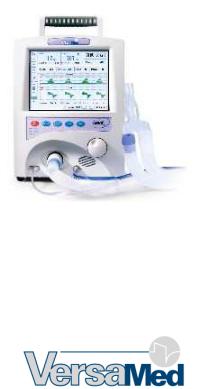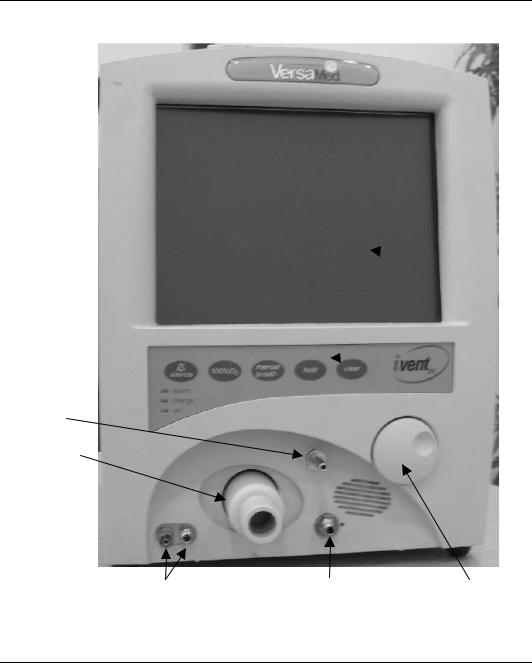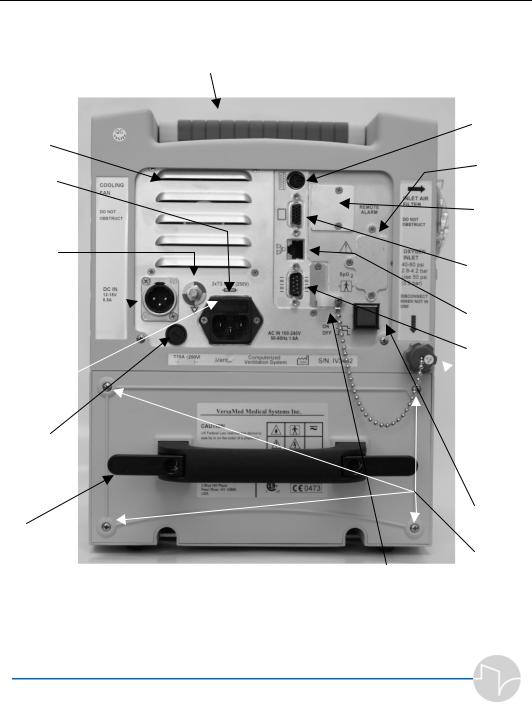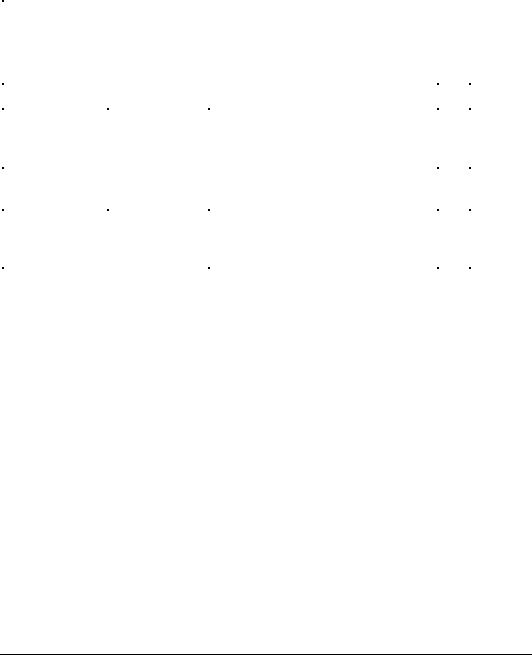VersaMed i Vent201 User Manual

iVent201
Operator’s Manual
iVent201 Operator’s Manual Part Number OM-01-04
Rev: 11 Revised: December 2006 Copyright © 2006 by VersaMed™ Medical Systems, Inc.
 0473
0473

iVent201 Operator's Manual
Manufacturer’s Address
P.O. Box 1512, Blue Hill Plaza, Pearl River, New York 10965 USA.
Authorized Representative in the European Community for regulatory affairs
Obelis S.A.
Av. de Tervuren 34, bte 44
B-1040 Brussels
Belgium
Tel: +32-2-732-59.54
Fax: +32-2-732-60.03
European Community Sales office:
Bismarckstr.77
46047 Oberhausen
Phone :+491732808345
Fax: +492088823267

iVent201 Operator's Manual
Calling for Help
Owner’s Record
The model number and serial number of your iVent201 are on the rear panel of your ventilator. Record the serial number in the space provided below to have this information should you need to call for service or support.
Model Number:
Serial Number:
Customer Support
and Service
If you have a ventilator problem you cannot solve and you purchased your ventilator directly from VersaMed, call:
800-475-9239 - Customer Care and Service Assistance Line
NOTE: If this ventilator has not been purchased directly from VersaMed, please ensure that it has been purchased from an authorized distributor of VersaMed. To obtain a list of authorized distributors contact VersaMed at sales@versamed.com.
If you have a ventilator problem that you cannot solve and you purchased your ventilator from an authorized VersaMed distributor, please contact your distributor directly to report the problem.
Manufacturer’s Address
P.O. Box 1512, Blue Hill Plaza, Pearl River, New York 10965 USA.
Authorized Representative in the European Community
Obelis S.A.
Av .de Tervuren 34, bte 44
B-1040 Brussels
Belgium
Tel: +32-2-732-59.54
Fax: +32-2-732-60.03
Visit our web site at versamed.com

iVent201 Operator's Manual
Table of Contents
1 |
Introduction ............................................... |
1 |
1.1 How To Use This Manual ...................................................................... |
3 |
|
1.2 |
Looking at the iVent201............................................................................ |
4 |
1.3 Cautions and Warnings .......................................................................... |
6 |
|
1.4 Symbols and Labels ................................................................................ |
8 |
|
1.5 |
Performance and Parameters ................................................................. |
9 |
1.6 |
Specifications........................................................................................... |
11 |
1.6.1 Monitored Data Range, Resolution and Accuracy ........................ |
11 |
|
1.6.2 Size and Weight ................................................................................ |
13 |
|
1.6.3 Ventilation Modes ............................................................................ |
14 |
|
1.6.4 Environmental Specifications .......................................................... |
14 |
|
1.6.5 Power Supply.................................................................................... |
15 |
|
1.6.6 O2 Supply Specifications ................................................................. |
15 |
|
1.6.7 Ventilation Performance and Controlled Parameters ................... |
16 |
|
1.7 |
Standards and Safety Requirements..................................................... |
17 |
1.8 |
Displayed Parameters ............................................................................. |
17 |
1.9 |
User Adjustable Alarms ......................................................................... |
19 |
1.10 Additional Alarms................................................................................. |
19 |
|
1.11 Waveforms and Diagnostics Packages ............................................... |
20 |
|
1.12 Intended Use .......................................................................................... |
21 |
|
1.13 Use of the iVent201 with MRi.............................................................. |
22 |
|
2 |
Setting Up................................................... |
27 |
2.1 Power Connection ................................................................................... |
28 |
|

iVent201 Operator's Manual |
|
|
2.1.1 External power.................................................................................. |
28 |
|
2.1.2 Internal Battery ................................................................................. |
31 |
|
2.2 Oxygen Supply ........................................................................................ |
36 |
|
2.2.1 High Pressure Oxygen Supply ........................................................ |
36 |
|
2.2.2 Low Pressure Oxygen Supply ......................................................... |
38 |
|
2.3 |
Breathing Circuit ..................................................................................... |
39 |
2.3.1 Circuit Resistance.............................................................................. |
42 |
|
2.4 |
Other Connections................................................................................... |
43 |
2.4.1 HME................................................................................................... |
43 |
|
2.4.2 MDI .................................................................................................... |
43 |
|
2.4.3 Using the iVent201 with Heated Humidification (1.4 models |
|
|
|
only) ................................................................................................... |
43 |
2.4.4 Synchronized Nebulizer Device ...................................................... |
46 |
|
2.4.5 Pulse Oximeter.................................................................................. |
47 |
|
2.4.6 Sensor Line Maintenance ................................................................. |
50 |
|
2.5 |
Patient Connection .................................................................................. |
50 |
2.6 |
Filters......................................................................................................... |
51 |
2.6.1 Air Inlet Filter.................................................................................... |
51 |
|
2.6.2 Bacterial Filter ................................................................................... |
51 |
|
2.6.3 Chemical, Biological, Radiological, and Nuclear Filter ................. |
52 |
|
2.7 |
Operational Case ..................................................................................... |
53 |
2.8 |
The iVent201 User Interface..................................................................... |
54 |
2.9 Controls and Powering Up ..................................................................... |
55 |
|
2.9.1 The Front Panel ................................................................................. |
55 |
|
2.9.2 LED Indicators .................................................................................. |
58 |
|
2.9.3 The Screen ......................................................................................... |
59 |
|
3Operating the iVent201 – Setting Modes
and Parameters........................................... |
63 |

iVent201 Operator's Manual |
|
|
|
3.1 Operation.................................................................................................. |
63 |
|
3.1.1 Power Up and Weight Selection ..................................................... |
63 |
|
3.1.2 O.V.T.................................................................................................. |
65 |
|
3.1.3 Standby and Patient Ventilation ..................................................... |
69 |
|
3.1.4 Changing Ventilation Mode ............................................................ |
69 |
|
3.1.5 Changing Ventilation Parameters - Overview............................... |
74 |
|
3.2 Common Parameters ............................................................................... |
78 |
|
3.3 The Selection Interface ........................................................................... |
79 |
|
3.3.1 Adjusting Breath Rate ...................................................................... |
80 |
|
3.3.2 Adjusting Tidal Volume .................................................................. |
83 |
|
3.3.3 Adjusting Pressure Limits in Volume Control Ventilation |
|
|
Modes ................................................................................................ |
87 |
|
3.3.4 Adjusting FiO2 .................................................................................. |
89 |
|
3.3.5 Adjusting Peak Flow ........................................................................ |
91 |
|
3.3.6 Adjusting Pressure Support Ventilation......................................... |
93 |
|
3.3.7 Adjusting PEEP................................................................................. |
95 |
|
3.3.8 Adjusting Trigger Sensitivity .......................................................... |
96 |
|
3.3.9 Adjusting Inspiratory Time ............................................................. |
98 |
4 |
The Main Menu......................................... |
101 |
|
4.1 Navigating the Main Menu.................................................................... |
102 |
|
4.2 Alarm Settings ......................................................................................... |
103 |
|
4.2.1 Changing Individual Alarm Settings.............................................. |
103 |
|
4.2.2 Auto Settings..................................................................................... |
117 |
|
4.2.3 Alarm Options .................................................................................. |
118 |
|
4.3 Advanced Settings................................................................................... |
125 |
|
4.3.1 Sigh Breath ........................................................................................ |
127 |
|
4.3.2 Rise Time........................................................................................... |
128 |
|
4.3.3 Easy Exhale™.................................................................................... |
130 |

iVent201 Operator's Manual |
|
|
|
4.3.4 Oxygen Supply ................................................................................. |
132 |
|
4.3.5 Adaptive Peak Flow ......................................................................... |
140 |
|
4.3.6 Set Purge Interval ............................................................................. |
141 |
|
4.3.7 Pulse Oximetery................................................................................ |
143 |
|
4.3.8 Synchronized Nebulizer................................................................... |
148 |
|
4.3.9 Set Time and Date............................................................................. |
150 |
|
4.4 Restore Default Settings ......................................................................... |
153 |
|
4.4.1 To Restore Defaults:.......................................................................... |
153 |
|
4.5 Show Graphs............................................................................................ |
157 |
|
4.5.1 Browse Waveforms........................................................................... |
158 |
|
4.5.2 Select Range....................................................................................... |
160 |
|
4.6 Show Trends............................................................................................. |
163 |
|
4.6.1 Selecting Trends To Display ............................................................ |
166 |
|
4.6.2 Browsing Trends............................................................................... |
168 |
|
4.7 Show Loops .............................................................................................. |
170 |
|
4.8 Show Mechanics ...................................................................................... |
173 |
|
4.9 Show Log Book ........................................................................................ |
174 |
|
4.10 Display .................................................................................................... |
175 |
|
4.11 O.V.T. ...................................................................................................... |
178 |
|
4.12 Maintenance ........................................................................................... |
178 |
5 |
Adaptive Bi-Level...................................... |
179 |
|
5.1 About Adaptive Bi-Level ........................................................................ |
179 |
|
5.2 Guide to Adaptive Bi-Level.................................................................... |
180 |
|
5.3 Indications and Warning ........................................................................ |
181 |
|
5.3.1 Indications ......................................................................................... |
181 |
|
5.4 Setup.......................................................................................................... |
181 |
|
5.4.1 Adaptive Bi-Level Alarm Settings................................................... |
183 |
|
5.4.2 Other Alarm Options........................................................................ |
184 |

iVent201 Operator's Manual |
|
|
5.5 |
Adjusting Adaptive Bi-Level Parameters............................................. |
186 |
5.6 Adaptive Bi-Level Window.................................................................... |
187 |
|
5.7 Easy Exhale™ ........................................................................................... |
188 |
|
5.8 |
Optimizing the Patient Ventilator Interface........................................ |
189 |
5.9 |
Resolving Patient Ventilator Dysynchrony ......................................... |
189 |
6 |
Alarms ......................................................... |
193 |
6.1 How Alarms Work................................................................................... |
193 |
|
6.1.1 Responding to an Alarm.................................................................. |
194 |
|
6.1.2 Alarm settings................................................................................... |
196 |
|
6.2 |
Guide to Alarm Definitions and Priorities .......................................... |
199 |
6.3 |
Alarms Tests............................................................................................. |
209 |
6.4 |
The Sensor Failure Alarm....................................................................... |
215 |
6.5 |
Patient Disconnect Alarm....................................................................... |
218 |
6.6 |
Patient Circuit Failed Alarm .................................................................. |
219 |
7 |
Care, Maintenance, and Tests ................. |
221 |
7.1 Cleaning and Maintenance .................................................................... |
221 |
|
7.2 |
Preventive Maintenance ......................................................................... |
222 |
7.3 The O.V.T. ................................................................................................ |
223 |
|
7.4 The Maintenance Screen ........................................................................ |
224 |
|
7.4.1 Calibration......................................................................................... |
224 |
|
7.4.2 Ventilator Verification Tests ............................................................ |
224 |
|
7.5 |
Configuration Screen .............................................................................. |
232 |
7.5.1 Choosing a different Startup Screen ............................................... |
232 |
|
7.5.2 Setting the startup weight................................................................ |
233 |
|
7.5.3 Default FiO2 Setting.......................................................................... |
234 |
|
7.6 |
VersaMed Service Functions ................................................................. |
234 |
7.7 Communication Rate .............................................................................. |
235 |
|

iVent201 Operator's Manual |
|
|
7.8 Localization .............................................................................................. |
235 |
|
7.9 Total Operating Hours ............................................................................ |
238 |
|
Appendix A : Glossary..................................... |
239 |
|
Appendix B : Warranty .................................... |
247 |
|
Appendix C : Operating Theory .................... |
251 |
|
C.1 |
Ambient Air Filter ............................................................................ |
251 |
C.2 |
CBRN Filter (optional) ................................................................... |
251 |
C.3 |
Low Pressure O2 Adapter and Filter (optional) .................... |
251 |
C.4 Air/Oxygen Blending System...................................................... |
251 |
|
C.5 |
Inlet Manifold.................................................................................... |
251 |
C.6 Turbine Unit ....................................................................................... |
252 |
|
C.7 |
Turbine Pressure Sensor................................................................ |
252 |
C.8 Turbine Valves .................................................................................. |
252 |
|
C.9 |
Over Pressure Relief Valve........................................................... |
252 |
C.10 Airway Flow and Pressure Sensors......................................... |
252 |
|
C.11 Pressure Switch ............................................................................... |
252 |
|
C.12 Inlet and Outlet Mufflers............................................................ |
252 |
|
Appendix D : Theory of Breath Delivery ..... |
255 |
|
D.1 Breath Delivery....................................................................................... |
255 |
|
D.2 Patient Triggering .................................................................................. |
256 |
|
D.3 Breath Types ........................................................................................... |
258 |
|
D.3.1 Adaptive FlowTM and Adaptive I-Time™...................................... |
259 |
|
D.3.2 Mandatory Volume Control Breath................................................ |
262 |
|
D.3.3 Pressure Control Breath................................................................... |
263 |
|

iVent201 Operator's Manual |
|
D.3.4 Manual Mandatory Breath .............................................................. |
264 |
D.3.5 Patient Pressure Support Breath..................................................... |
265 |
D.3.6 Patient Spontaneous Breath ............................................................ |
266 |
D.4 Summary ................................................................................................. |
267 |
Appendix E : Ventilation Modes ................... |
269 |
E.1 Assist/Control Mode............................................................................... |
269 |
E.1.1 Definition........................................................................................... |
269 |
E.1.2 Available Breath Types .................................................................... |
269 |
E.1.3 Description ........................................................................................ |
269 |
E.1.4 Parameters Setting............................................................................ |
270 |
E.2 Synchronized Intermittent Mandatory Ventilation Mode................ |
271 |
E.2.1 Definition........................................................................................... |
271 |
E.2.2 Available Breath Types .................................................................... |
271 |
E.2.3 Description ........................................................................................ |
272 |
E.2.4 Parameters Setting............................................................................ |
273 |
E.3 Continuous Positive Airway Pressure Mode ...................................... |
273 |
E.3.1 Definition........................................................................................... |
273 |
E.3.2 Available Breath Types .................................................................... |
273 |
E.3.3 Description ........................................................................................ |
273 |
E.3.4 Parameters Setting............................................................................ |
274 |
E.4 Apnea Back-Up Ventilation................................................................... |
275 |
E.5 Open Loop Mode .................................................................................... |
276 |
E.6 Adaptive Bi-Level Mode ........................................................................ |
276 |
Appendix F : Hold Function and Static |
|
Mechanics Measurements ....................... |
277 |
F.1 Front Panel Controls ............................................................................... |
277 |
F.2 Static Compliance Measurements......................................................... |
278 |

iVent201 Operator's Manual |
|
F.2.1 Static Compliance.............................................................................. |
278 |
F.2.2 Respiratory Time Constant ............................................................. |
279 |
F.2.3 Performing a Static Respiratory Mechanics Measurement ........... |
279 |
F.2.3.1 Table - Maximum Inspiratory Hold Time for Different Tidal |
|
Volumes: ............................................................................................ |
281 |
F.2.3.2 Table - Maximum Expiratory Hold Time for Different Tidal |
|
Volumes............................................................................................. |
281 |
F.2.4 Clinical Considerations..................................................................... |
282 |
F.3 End Expiratory Hold ............................................................................... |
282 |
F.3.1 Performing and End Expiratory Hold Maneuver .......................... |
283 |
F.3.2 Reviewing Static Mechanics and Intrinsic PEEP Measurements .. |
284 |
F.4 RR/Vt Ratio ............................................................................................. |
285 |
Appendix G : Part Numbers and |
|
Accessories.................................................. |
287 |
Appendix H : Index .......................................... |
291 |

iVent201 Operator's Manual
1 Introduction
The iVent201 is a compact, portable, fully-featured, microprocessor-controlled ventilator offering the versatility and capability of larger and costlier ventilators. A turbine-powered air source and a rechargeable internal battery provide freedom from wall air and power outlets. An intuitive turn-and-click control knob, quick-choice pushbuttons, and a bright, wellorganized, easy-to-read screen allow rapid control and continuous real-time monitoring of patient ventilation. Alarm settings are fully adjustable. Optional Waveform and Diagnostic Software package displays pressure and flow waveform data, loops, trends, and logged totals in a full array of graphical and numerical modes.
The iVent201 supports many modes:
•Assist/Control
•Volume Controlled A/C
•Pressure Controlled A/C
•Synchronized Intermittent Mandatory Ventilation (SIMV)
•Volume Controlled SIMV (Vctrl SIMV)
•Pressure Controlled SIMV (Pctrl SIMV)
•Continuous Positive Airway Pressure (CPAP)
•Pressure Support Ventilation (PSV)
1

Introduction
(Note: Certain modes are optional features and may not be operational in some iVent201 models.)
In addition, the iVent201 has these advanced features:
•Rise time is adjustable
•Preset Parameters by Patient Weight enables quick setup
•Adaptive Peak Flow can determine and deliver Inspiratory Peak Flow Rate according to a target mandatory tidal volume, maintaining a 1:2 I:E ratio
•Adaptive I-Time allows the ventilator to determine and deliver a respiratory cycle time to sustain a 1:2 I:E ratio
•The iVent201's Adaptive Bi-Level feature enables leak-tolerance for facemask ventilation or other specialized high-leak tube ventilation
•Easy Exhale is an advanced PEEP mode designed to reduce expiratory work of breathing
•Firmware is upgradeable via a PC connection
•The iVent201 is designed to operate according to specifications in any physical orientation – such as during transport use
2

iVent201 Operator's Manual
1.1 How To Use This Manual
You must read this manual before you use the iVent201. In particular, the first several sections are critical for an understanding of the iVent. This manual is primarily organized according to the available screens, menus, options and settings and begins with a look at the hardware, including power considerations and patient circuit setup.
Study them with the iVent close at hand, along with a patient circuit (preferably with a test lung and Rp20 resistor). Become comfortable with the control knob and the front panel buttons.
The user interface consists of three primary screens/menus:
•The Main Screen
•The Main Menu
•The Mode Menu
Just about every function or operation of the iVent is accessible through one of these screens. Be aware of the notes, warnings, and cautions, generally marked in bold print.
Useful user tips are in bold and set off with an arrow.
Refer to the index if you need information. Table 1.1 may also be used as a general guide.
If you are not familiar with Adaptive Bi-Level feature, read Section 05 (page 179).
3

Introduction
1.2 Looking at the iVent201
 Display
Display
 Keypad
Keypad
Nebulizer outlet
Ventilator outlet
Sensor line luer inlets |
Exhalation valve luer inlet |
Control knob |
Figure 1.1 Front View of the iVent201
4

iVent201 Operator's Manual
Carrying handle
Cooling fan
AC cord connector
Grounding pin
DC cord  connector
connector
AC fuses 
DC fuse
Internal battery handle
Keyboard connector
SPO2 probe connector
Remote alarm connector
External screen connector
LAN connector
RS 232  connector
connector
High pressure oxygen inlet connector
On/off switch
Battery
pack AC cable clip screws
(4)
Figure 1.2 Rear View of the iVent201
5

Introduction
1.3 Cautions and Warnings
WARNING: The iVent201 is a life-sustaining device. Do not rely solely on the ventilator performance: always make sure an alternative source of ventilation is available. Clinical supervision of the patient is mandatory.
CAUTION: The iVent201 is a restricted medical device to be operated by qualified medical personnel under the direction of a qualified medical practitioner.
WARNING: Qualified medical personnel should visually monitor patients on life-support ventilation. Life-threatening conditions may arise that might not activate alarms.
CAUTION: Always perform a complete Operation Verification Test (O.V.T.) when connecting a new patient circuit to the ventilator, and before using it on a patient. Standard facility policy should be followed.
WARNING: Do not use the iVent201 ventilator to treat infants weighing less than 10 kg/ 22 lb.
CAUTION: The factory default setting for “Leak Alarm” is set to ”off.” Users must manually set the leak alarm to enable it.
WARNING: To prevent explosion hazard, do not use the ventilator in the presence of flammable anaesthetics.
6

iVent201 Operator's Manual
CAUTION: Using the iVent201 in combination with devices such as humidifiers or filters can increase the pressure gradient across the breathing system. Make sure that such devices do not produce excessive resistance to the airflow provided by the iVent201.
WARNING: Do not cover the iVent201 while it is in use. Make sure that the iVent201 is positioned so that its inlet ports and cooling vents are open to freely circulating air.
CAUTION: The iVent201 must not be operated immediately following storage or transport outside the recommended operation condition.
CAUTION: The iVent201 internal battery contains lead and must be disposed of in accordance with local ordinances and environmental regulations.
CAUTION: Do not connect the O2 supply when equipment is not in use.
7

Introduction
1.4 Symbols and Labels
Indicates that you should “Refer to documentation for further information.” Refer to manual per IEC 601-1
Potential equalization (Ground) point
Direct Current ( DC) and Alternating Current (AC)
Type BF equipment, per IEC 601-1
8

iVent201 Operator's Manual
1.5 Performance and Parameters
Ventilation |
Parameters/ |
Unit of |
Accuracy |
Set |
Displayed |
Page |
Component |
Range |
Measure |
|
|||
|
|
|
|
|||
|
|
|
|
|
|
|
Respiratory |
1-12 |
bpm |
±1 |
Y |
Y |
80 |
|
|
|
|
|||
rate |
12-80 |
|
±2 |
|
|
|
|
|
|
|
|
||
|
|
|
|
|
|
|
Inspired Tidal |
50-2000 |
mL |
±10% |
Y |
Y |
83 |
Volume |
|
|
|
|
|
|
Measurement |
|
|
|
|
|
|
|
|
|
|
|
|
|
Exhaled Tidal |
50-300 |
mL |
±10 mL or +15% |
Y |
Y |
|
Volume |
|
|
whichever is greater |
|
|
|
Measurement |
300-2000 |
|
+10% |
|
|
|
|
|
|
|
|
||
|
|
|
|
|
|
|
Inspiratory |
5 to 80 |
cmH2O |
±5 |
N |
Y |
87 |
Pressure Limit |
|
|
|
|
|
|
|
|
|
|
|
|
|
Inspiratory |
0.2 to 3 or |
sec. |
±10% |
Y |
Y |
98 |
Time |
Adaptive I- |
|
|
|
|
|
|
Time |
|
|
|
|
|
|
|
|
|
|
|
|
Peak Flow |
up to 120 or |
L/min |
±10% |
Y |
Y |
91 |
|
Adaptive |
|
|
|
|
|
|
Flow |
|
|
|
|
|
|
|
|
|
|
|
|
Peak Flow |
up to 180 |
L/min |
±10% |
Y |
Y |
91 |
(Spontaneous) |
|
|
|
|
|
|
|
|
|
|
|
|
|
Oxygen Mix |
21 to 100% |
|
±5% |
Y |
Y |
89 |
(FiO2) |
|
|
|
|
|
|
|
|
|
|
|
|
|
PEEP |
0 to 40 |
cmH2O |
±1 or ±10%, |
Y |
Y |
95 |
|
|
|
whichever is greater |
|
|
|
|
|
|
|
|
|
|
Trigger |
1 to 20, off |
L/min |
|
Y |
Y |
96 |
sensitivity |
-0.5 to –20, off |
cmH2O |
|
|
|
|
|
|
|
|
|
|
|
|
|
|
|
|
|
|
9

|
|
|
|
|
|
|
Introduction |
|||
|
|
|
|
|
|
|
|
|
|
|
|
Ventilation |
Parameters/ |
Unit of |
Accuracy |
Set |
Displayed |
|
Page |
|
|
|
Component |
Range |
Measure |
|
|
|
||||
|
|
|
|
|
|
|
|
|||
|
|
|
|
|
|
|
|
|
|
|
|
PSV |
0 to 60 |
cmH2O |
±10% |
Y |
Y |
|
93 |
|
|
|
|
|
|
|
|
|
|
|
|
|
|
Positive |
80 |
cmH2O |
|
N |
N |
|
|
|
|
|
Pressure relief |
|
|
|
|
|
|
|
|
|
|
valve |
|
|
|
|
|
|
|
|
|
|
|
|
|
|
|
|
|
|
|
|
|
Controlled |
5 to 80 |
cmH2O |
±5 |
Y |
Y |
|
|
|
|
|
Pressure |
|
|
|
|
|
|
|
|
|
|
|
|
|
|
|
|
|
|
|
|
|
FiO2 at power |
21%, 40%, |
|
|
Y |
Y |
|
234 |
|
|
|
up |
60%, 100% |
|
|
|
|
|
|
|
|
|
|
(selectable) |
|
|
|
|
|
|
|
|
|
|
|
|
|
|
|
|
|
|
|
|
Purging cycle |
1, 2, 5, 10, off |
minute |
|
Y |
Y |
|
141 |
|
|
|
|
|
s |
|
|
|
|
|
|
|
|
|
|
|
|
|
|
|
|
|
|
10

iVent201 Operator's Manual
1.6 Specifications
1.6.1Monitored Data Range, Resolution and Accuracy
Parameter |
Range, resolution, accuracy |
|
|
Breath type |
Range: Type: - Control, assist, spontaneous, sigh |
|
Resolution: N/A |
|
Accuracy: N/A |
|
|
Respiratory |
Range: 0 to 150/min |
Rate |
Resolution: 1/min |
|
|
|
Accuracy: ±1 for 1 to 12/min |
|
±2 for 12 to 150/min |
|
|
Exhale tidal |
Range: 0 to 5000 mL |
volume |
Resolution: 1 mL |
|
|
|
Accuracy: ±10 mL or ±15% (whichever is greater) |
|
for 0 to 300 mL |
|
±10% for 300 to 5000 mL |
|
|
Exhaled Minute |
Range: 0 to 99.9L |
Volume |
Resolution: 0.1 L |
|
|
|
Accuracy: ±10% |
|
|
Peak flow |
Range: 0 to 140 L/min |
|
Resolution: 1 L/min |
|
Accuracy: ±10% |
|
|
11

Introduction
Parameter |
Range, resolution, accuracy |
|
|
|
|
|
|
|
PIP (Peak |
Range: 0 to 99 cmH2O |
|
|
Inspiratory |
Resolution: 1 cmH2O |
|
|
Pressure) |
|
|
|
|
|
|
|
|
Accuracy: ± 2 (+ 5 % of reading) cm H2O |
|
|
|
|
|
|
Inspiratory time |
Range: 0 to 3.0 sec |
|
|
|
Resolution: 0.1 sec |
|
|
|
Accuracy: ±10% |
|
|
|
|
|
|
I:E ratio |
Range: 1:11 to 3:1 |
|
|
|
Resolution: 0.1 for 1:1 to 1:5 |
|
|
|
1 for 1:5 to 1:11 and 3:1 to 1:1 |
|
|
|
Accuracy: ±0.1 |
|
|
|
|
|
|
Delivered O2% |
Range: 21 to 100% |
|
|
|
Resolution: 1% |
|
|
|
Accuracy: ±5% |
|
|
|
|
|
|
Flow Leak |
Range: 0 to 100% |
|
|
|
Resolution: 1% |
|
|
|
Accuracy: ±15% |
|
|
|
|
|
|
Mean Airway |
Range: 0 to 99 cmH2O |
|
|
Pressure |
Resolution: 1 cmH2O |
|
|
|
|
|
|
|
Accuracy: ± 2 (+ 5 % of reading) cmH2O |
|
|
|
|
|
|
Resistance |
Range: 0 to 99.9 cmH2O/L/s |
|
|
(dynamic) |
Resolution: 0.1 cmH2O/L/s |
|
|
|
|
|
|
|
Accuracy: ± (2 + 20% of actual value) cmH2O/L/s |
|
|
|
|
|
|
Compliance |
Range: 0 to 99.9 ml/cmH2O |
|
|
(dynamic) |
Resolution: 0.1 ml/cmH2O |
|
|
|
|
|
|
|
Accuracy: ± (2 +20% of actual value) ml/cmH2O |
|
|
|
|
|
|
|
|
|
12

iVent201 Operator's Manual
Parameter |
Range, resolution, accuracy |
|
|
|
|
RR/Vt-Rapid |
Range: 0 –200 /min*L |
|
Shallow |
Resolution: 1 /min*L |
|
Breathing Index |
||
|
||
(RSBI) |
Accuracy: ± (5 + 20% of actual value). /min*L |
|
|
|
|
Static |
Range: 0 to 99 ml/cmH2O |
|
compliance |
Resolution: 1 ml/cmH2O |
|
|
||
|
Accuracy: ± (2 + 20 % of actual value). ml/cmH2O |
|
|
|
|
Auto PEEP |
Range: 0 to 99 cmH2O |
|
|
Resolution: 1 cmH2O |
|
|
Accuracy: ± 2 (+ 5 % of reading) cmH2O |
|
|
|
|
Time Constant |
Range: 0.0 to 9.9 sec |
|
|
Resolution: 0.1 sec |
|
|
Accuracy: ±20% |
|
|
|
1.6.2Size and Weight
Height: |
13” / 33 cm |
Width: |
9.5” / 24 cm |
Depth: |
10.3” / 26 cm |
Screen: |
8.4” / 21.3 cm diagonal |
Weight |
15.4 lb / 7 kg (without battery) |
Battery Weight |
6.5 lb / 3 kg |
Overall Weight |
22 lb / 10 kg |
13

Introduction
1.6.3Ventilation Modes
•Assist/Control (A/C
•Volume Controlled (A/C)
•Pressure Controlled (A/C)
•Synchronized Intermittent Mandatory Ventilation (SIMV)
•Volume Controlled SIMV (Vctrl)
•Pressure Controlled SIMV (Pctrl)
•Continuous Positive Airway Pressure (CPAP) with Pressure Support Ventilation (PSV)
Note: Certain modes are not operational in all iVent201 models.
1.6.4Environmental Specifications
Operating Temperature |
-15 to +50 °C / +5 to +122 °F |
|
|
Storage Temperature |
without battery: -15 to +70 °C / +5 to +158 |
|
°F |
|
with battery: -15 to +30 °C / +5 to +86 °F |
|
|
Relative Humidity |
15 to 95% @ 30 °C / 86 °F |
|
|
Water and Dust |
IP-54 (Splash proof) |
Resistance |
|
|
|
Atmospheric Pressure |
430 - 825 mmHg (up to 15,000 feet) |
|
|
Vibration |
IEC 68-2-6, IEC 68-2-34 |
|
MIL-STD-810E |
|
|
14

iVent201 Operator's Manual
Shock |
IEC 68-2-27 (100 g) |
|
MIL-STD-810E |
|
|
Total External Sound |
40 – 45 dBa at one meter |
Level |
|
1.6.5Power Supply
External AC |
100 to 240 V, 50-60 Hz, max 1.6 A. |
External DC |
12 to 15 V max 8.5 A. |
Battery |
|
Internal Battery |
Sealed Lead-Acid, 12 V 8 Ah (rechargeable) |
Recharge Time |
Over 8 hours, <1 Ampere |
Operating Time |
Up to 2 hours (varies with ventilation |
(internal battery) |
parameters) |
1.6.6O2 Supply Specifications
Pressure Range |
40-60 psi (2.8-4.2 bar) |
Minimum flow |
120L/min at 40 psi (2.8 bar) |
15

Introduction
1.6.7Ventilation Performance and Controlled Parameters
Respiratory Rate |
1 – 12 ±1, 12 – 80 ± 2 bpm |
Tidal Volume |
50-2000 mL |
Accuracy of Tidal |
±10% or ±10 mL whichever is greater |
Volume Delivery |
|
Accuracy of Respiratory
Volume Measurement
Inspiratory Pressure
Limit
±15% above 100 mL from actual reading or ±10 cc below 100 mL
5 to 80 ±5 cmH2O
Inspiratory Time |
Adaptive TimeTM or 0.2 to 3 ±10% sec |
Peak Flow (PIF) |
Adaptive FlowTM or to 120 ±10% L/min |
|
Spontaneous to 140 ±10% L/min |
Oxygen Mix (FiO2 ) |
21% to 100% ±5% O2 |
PEEP |
0 to 40 ±1 cmH2O or ±10%, whichever is |
|
greater |
Trigger Sensitivity |
1 to 20 L/min Flow, Off |
|
- 0.5 to – 20 cmH2O Pressure, Off |
PSV |
0 to 60 ±10% cmH2O |
Positive Pressure Relief |
80 cmH2O |
Valve |
|
Controlled Pressure |
5 to 80 cm ±5 cm |
FiO2 at Power up |
21%, 40%, 60%, 100% (configurable) |
Purging Cycle |
1, 2, 5, 10 minutes, Off (configurable) |
16

iVent201 Operator's Manual
1.7 Standards and Safety Requirements
The iVent201 meets or exceeds the following international standards:
ISO 10651-1 |
Lung Ventilators for medical use |
ISO 10651-2 |
Particular requirements for Home Care Ventilators |
ISO 10651-3 |
Requirements for Emergency and Transport |
|
Ventilators |
ASTM F1100-90 |
Standard Specifications for Ventilators intended |
|
for use in Critical Care |
IEC 60601-1 |
Electrical Safety |
IEC 60601-1-2 |
Electromagnetic Compatibility (EMC) |
IEC 60601-2-12 |
Medical Electrical Equipment – Particular |
|
Requirements for the Safety of Lung Ventilators - |
|
Critical Care Ventilators |
UL 60601-1 |
Medical Electrical Equipment, part1: General |
|
Requirements for Safety |
ASTM F1246-96 |
Standard Specification for Electrically Powered |
|
Home Care Ventilation. |
1.8 Displayed Parameters
The following table presents the displayed parameters and indicates whether the displayed values are set, measured or both.
|
Unit of |
Set |
Displayed |
Parameter |
Measure |
||
|
|||
|
|
||
|
|
|
|
Exhaled Tidal Volume (VT) |
mL |
+ |
+ |
|
|
|
|
Rate |
bpm |
+ |
+ |
|
|
|
|
Ventilation Mode |
|
+ |
+ |
|
|
|
|
|
|
|
17 |

Introduction
|
Unit of |
Set |
Displayed |
|
|
|
|
Parameter |
Measure |
|
|
|
|
|
|
|
|
|
|
Oxygen Concentration |
FiO2 |
+ |
+ |
|
|
|
|
Inspiration to Expiration time ratio I:E ratio |
|
|
+ |
|
|
|
|
Inspiratory Time (Itime) |
sec |
+ |
+ |
|
|
|
|
Sensitivity Values (Triggers): Pressure and |
cmH2O/LPM |
+ |
+ |
Flow |
|
|
|
|
|
|
|
Pressure Support Ventilation (PSV) |
cmH2O |
+ |
|
|
|
|
|
Alarm Pressure / Limit Pressure |
cmH2O |
+ |
+ |
|
|
|
|
Positive End Expiratory Pressure (PEEP) |
cmH2O |
+ |
+ |
|
|
|
|
Exhaled Minute Volume |
L |
|
+ |
|
|
|
|
Peak Inspiratory Pressure |
cmH2O |
|
+ |
|
|
|
|
Pressure/Flow Wave Forms |
|
|
+ |
|
|
|
|
Electrical Power Source (Ext./Int.) |
|
|
+ |
|
|
|
|
In Adaptive Bi-Level Mode: |
|
|
|
|
|
|
|
P High (Ins Pressure) |
cmH2O |
+ |
+ |
|
|
|
|
P Low (Exp. Pressure) |
cmH2O |
+ |
+ |
|
|
|
|
Tidal Volume (estimated) |
mL |
|
+ |
|
|
|
|
Leak (estimated) |
LPM |
|
+ |
|
|
|
|
Rise Time Setting |
|
+ |
|
|
|
|
|
Non-Displayed Additional Parameters |
|
|
|
|
|
|
|
Sigh Breath Setting |
|
+ |
|
|
|
|
|
Purge Cycle Setting |
|
+ |
|
|
|
|
|
18
